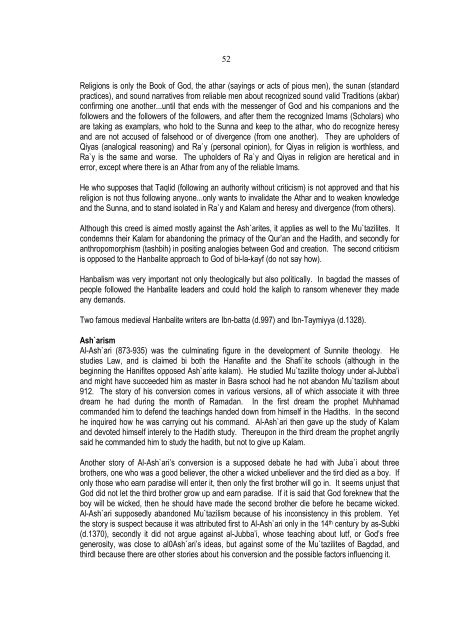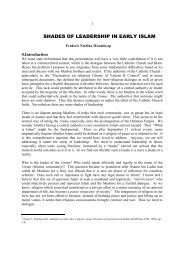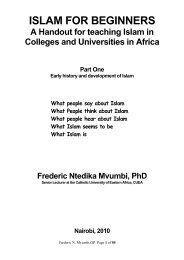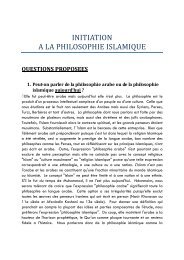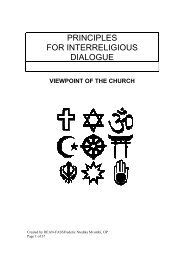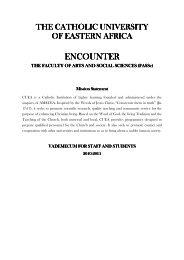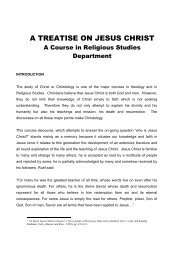INTRODUCTION TO ISLAMIC THEOLOGY.pdf - CUEA
INTRODUCTION TO ISLAMIC THEOLOGY.pdf - CUEA
INTRODUCTION TO ISLAMIC THEOLOGY.pdf - CUEA
You also want an ePaper? Increase the reach of your titles
YUMPU automatically turns print PDFs into web optimized ePapers that Google loves.
52Religions is only the Book of God, the athar (sayings or acts of pious men), the sunan (standardpractices), and sound narratives from reliable men about recognized sound valid Traditions (akbar)confirming one another...until that ends with the messenger of God and his companions and thefollowers and the followers of the followers, and after them the recognized Imams (Scholars) whoare taking as examplars, who hold to the Sunna and keep to the athar, who do recognize heresyand are not accused of falsehood or of divergence (from one another). They are upholders ofQiyas (analogical reasoning) and Ra`y (personal opinion), for Qiyas in religion is worthless, andRa`y is the same and worse. The upholders of Ra`y and Qiyas in religion are heretical and inerror, except where there is an Athar from any of the reliable Imams.He who supposes that Taqlid (following an authority without criticism) is not approved and that hisreligion is not thus following anyone...only wants to invalidate the Athar and to weaken knowledgeand the Sunna, and to stand isolated in Ra`y and Kalam and heresy and divergence (from others).Although this creed is aimed mostly against the Ash`arites, it applies as well to the Mu`tazilites. Itcondemns their Kalam for abandoning the primacy of the Qur’an and the Hadith, and secondly foranthropomorphism (tashbih) in positing analogies between God and creation. The second criticismis opposed to the Hanbalite approach to God of bi-la-kayf (do not say how).Hanbalism was very important not only theologically but also politically. In bagdad the masses ofpeople followed the Hanbalite leaders and could hold the kaliph to ransom whenever they madeany demands.Two famous medieval Hanbalite writers are Ibn-batta (d.997) and Ibn-Taymiyya (d.1328).Ash`arismAl-Ash`ari (873-935) was the culminating figure in the development of Sunnite theology. Hestudies Law, and is claimed bi both the Hanafite and the Shafi`ite schools (although in thebeginning the Hanifites opposed Ash`arite kalam). He studied Mu`tazilite thology under al-Jubba’iand might have succeeded him as master in Basra school had he not abandon Mu`tazilism about912. The story of his conversion comes in various versions, all of which associate it with threedream he had during the month of Ramadan. In the first dream the prophet Muhhamadcommanded him to defend the teachings handed down from himself in the Hadiths. In the secondhe inquired how he was carrying out his command. Al-Ash`ari then gave up the study of Kalamand devoted himself interely to the Hadith study. Thereupon in the third dream the prophet angrilysaid he commanded him to study the hadith, but not to give up Kalam.Another story of Al-Ash`ari’s conversion is a supposed debate he had with Juba`i about threebrothers, one who was a good believer, the other a wicked unbeliever and the tird died as a boy. Ifonly those who earn paradise will enter it, then only the first brother will go in. It seems unjust thatGod did not let the third brother grow up and earn paradise. If it is said that God foreknew that theboy will be wicked, then he should have made the second brother die before he became wicked.Al-Ash`ari supposedly abandoned Mu`tazilism because of his inconsistency in this problem. Yetthe story is suspect because it was attributed first to Al-Ash`ari only in the 14 th century by as-Subki(d.1370), secondly it did not argue against al-Jubba’i, whose teaching about lutf, or God’s freegenerosity, was close to al0Ash`ari’s ideas, but against some of the Mu`tazilites of Bagdad, andthirdl because there are other stories about his conversion and the possible factors influencing it.


